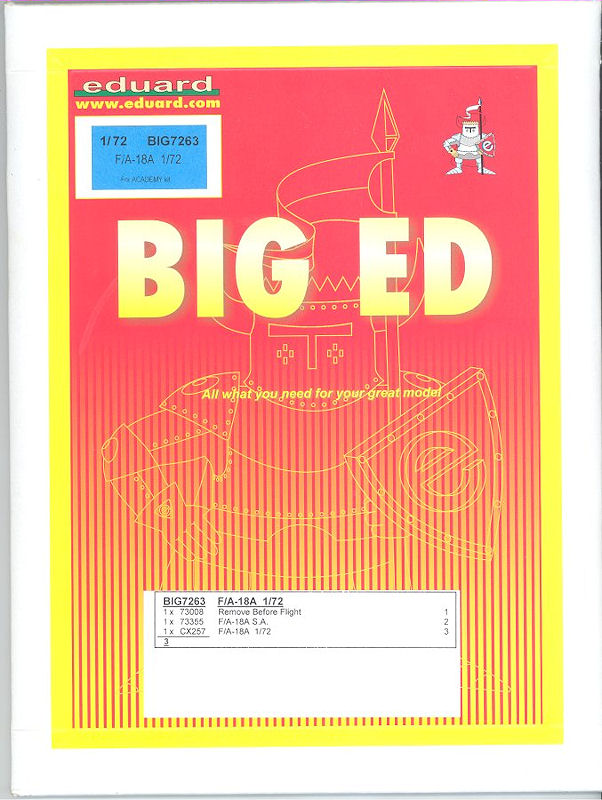Detail Set for the 1/72 Academy F/A-18A
The Contents
You get a heavy duty envelope with 4 plastic sleeves inside. You get:
- 73355 PE, one self-adhesive mostly cockpit, and two really big PE frets for interior and exterior detail
- CX257 Canopy and Wheel mask
- 73008 Remove Before Flight Tags
You also get 2 full pages of instructions, folded so that you have 8 separate half pages of instructions, plus a half page instruction for the masks.
The Aircraft
The F/A-18 Hornet has been around for a while, and it looks to be almost as big a winner as its predecessor, the F-4 Phantom. One of the stories going around St. Louis in the 90s was that the plant wanted to build 5058 Hornets, one more than the production run for the Phantom. Well, the production line is still open, and they’re past 1100 now.
The Academy kit is interesting to me because it has markings for a Spanish EF-18 and a Canadian CF-18, as well as an Australian aircraft. My decision was based on the fact that I worked with the Canadian 433 Squadron at an exercise in Wisconsin in 1995, and the markings are for the Porcupine Squadron.
Cockpit Assembly
I started with the seat and cockpit assembly. The self-adhesive PE for the seat and cockpit work pretty well, and sure save a lot of time and bother getting the parts in place and attached. They’re pre-painted, and the finished cockpit and seat look really great.
Exterior Details (and interior, too)
When I emailed John Noack to tell him that this project was going to take a little longer than I planned, I let him know that there are over 200 PE parts in the package. I figured that the model was going to weigh something like 5 pounds when I finished. OK, an exaggeration, but there are a lot of things on the Academy kit which are improved by added PE.
As an example, the splitter plates on the intakes have a screen. With the PE part, it’s an actual screen, not just an indicated area on the plastic part. The same with hydraulic lines on the landing gear, the screen in the flat area behind the seat, and the PE antennas. Each one makes the model look a little more like the real thing.
The one problem I had with assembly was a typo in the instructions. Behind the seat is that screen. Eduard’s instruction says it’s part C8. The actual part number is A25. Eduard picked up the number for a decal instead of the part number. Nevertheless, it took me a while to figure this one out.
Canopy Mask
With all of those other tiny parts to add on, it’s great to have something which is a time- and labor-saving device. The cockpit masks allowed me to put them on the clear parts, and then mount the windscreen on the aircraft permanently, after assembling and placing the HUD. I knocked the HUD off my F-16I many times, and this is how I can prevent that.
After masking the main canopy, I put it in place with Blu-Tak, which is used to temporarily mount posters on walls without marring the paint. Once I was through with the painting, I was able to pop the canopy off and peel off the Blu-Tak, leaving a clean edge.
I had some issues with Academy’s paint callouts, but otherwise the build was slow and uneventful. The decals were very good, although I found that the squadron markings changed between 1995 and 2004, and the porcupine looks suspiciously like a rat.
Overall Evaluation
Highly recommended. The Eduard cockpit is just head and shoulders above anything you find in a Hornet kit, and the canopy mask is something I’m going to try to save for my next F/A-18 project. If not, it’s worth buying another. The PE add-ons and replacements add a touch to the entire project.
When I started this project, I went through the Eduard and Academy instructions and noted where each instruction coincided with the same assembly on the other sheet. Even so, I wound up having to recheck both instructions to make sure I didn’t leave anything out, as neither sheet follows the same route from start to finish.
Thanks to Eduard for really enhancing my Academy kit, and to IPMS/USA for allowing me to review it.











Comments
Add new comment
This site is protected by reCAPTCHA and the Google Privacy Policy and Terms of Service apply.
Similar Reviews